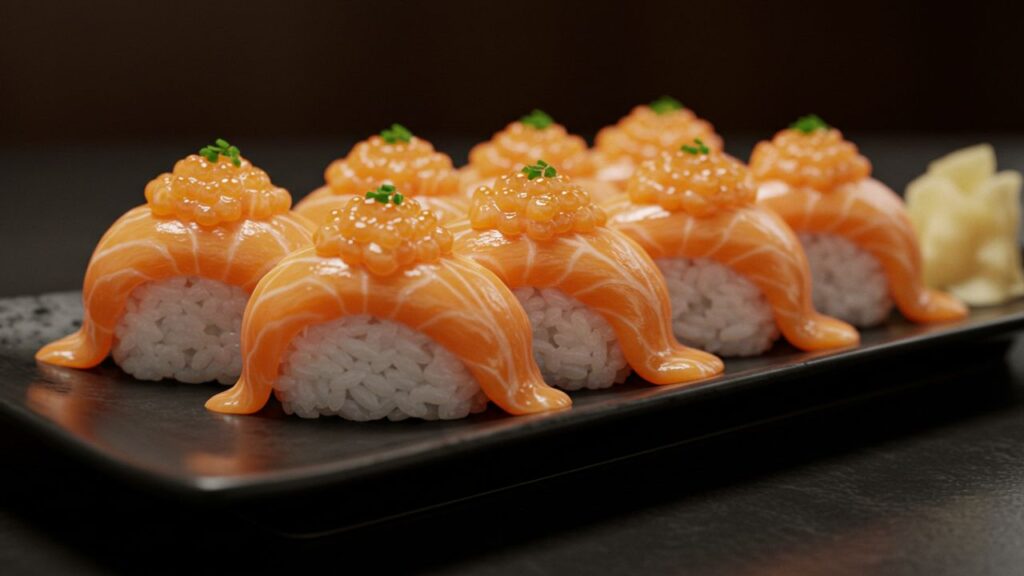Introduction
In recent years, food lovers and culinary writers alike have been buzzing about a specific sushi trend: the sushi order topped with salmon NYT has become a staple in modern sushi culture. This seemingly simple dish has gained critical acclaim not just from diners, but also from influential media outlets like The New York Times, which has spotlighted its popularity in American sushi restaurants.
This article dives deep into why the sushi order topped with salmon NYT is stealing the spotlight—from its fresh flavor profile and health perks to the cultural evolution of sushi in the U.S. We’ll also explore expert tips for ordering it right, and why it’s more than just a menu item—it’s a modern classic.
The Rise of the Sushi Order Topped with Salmon
A Brief History of Salmon in Sushi
Interestingly, salmon wasn’t traditionally used in Japanese sushi until the 1980s. Its introduction to sushi culture came via Norwegian export campaigns that promoted salmon as sushi-grade fish. Now, the sushi order topped with salmon NYT recognizes how far this ingredient has come—from newcomer to essential.
NYT’s Influence on Sushi Culture
The New York Times has frequently covered food trends, and the inclusion of a sushi order topped with salmon in its food columns or crossword puzzles reflects the dish’s cultural integration. It’s no longer just a delicacy; it’s a recognizable symbol of contemporary dining.
What Makes the Sushi Order Topped with Salmon NYT-Worthy?
1. Flavor and Texture Balance
Salmon offers a buttery texture and a rich, slightly sweet taste that pairs beautifully with vinegared rice. When prepared correctly, a sushi order topped with salmon melts in the mouth—offering both comfort and sophistication.
2. Visual Appeal
A piece of salmon nigiri or sushi roll topped with salmon often boasts vibrant orange hues with marbled white streaks. This makes it as Instagram-worthy as it is palate-pleasing—another reason why media outlets like NYT gravitate toward it.
3. Health Benefits
Salmon is high in omega-3 fatty acids, protein, and vitamin D. Including a sushi order topped with salmon in your diet not only delights your taste buds but also supports heart health, brain function, and muscle recovery.
Different Variations of the Sushi Order Topped with Salmon
Nigiri Sushi
The most common version is salmon nigiri—hand-pressed vinegared rice topped with a slice of raw salmon. This minimalist dish allows the quality of the fish to shine.
Salmon Maki Rolls
In maki rolls, the salmon is often accompanied by avocado, cucumber, or spicy mayo. These rolls provide a layered texture and flavor experience.
Seared (Aburi) Salmon Sushi
This variation involves lightly torching the salmon, which brings out a smoky flavor and intensifies the fatty richness of the fish.
Specialty Rolls
Creative chefs have started experimenting with truffle oil, citrus zest, or even caviar atop salmon sushi, elevating it into gourmet territory—something the NYT has highlighted in trend reports.
Where to Find the Best Sushi Order Topped with Salmon
New York City Hotspots
Given the NYT’s location, it’s no surprise that NYC sushi bars offer some of the most refined sushi orders topped with salmon. Popular spots like Sushi Yasuda, Nobu, and Sugarfish craft delicate salmon nigiri that live up to their reputation.
Nationwide Sushi Chains
Chains such as Sushi Roku, RA Sushi, and even Whole Foods’ sushi counters have adopted the trend, offering fresh, consistent salmon-topped sushi rolls across the U.S.
How to Order a Sushi Order Topped with Salmon Like a Pro
1. Know the Terms
Ask for “salmon nigiri” if you prefer the traditional fish-over-rice format, or “salmon maki” for a roll. Want it slightly cooked? Say “aburi salmon.”
2. Ask About the Cut
Sushi chefs often have belly cuts (more fatty) and back cuts (leaner). Requesting “sake toro” will get you the prized fatty belly cut for a melt-in-your-mouth texture.
3. Consider Pairings
Salmon pairs well with sake, green tea, or dry white wine. Wasabi and soy are traditional, but don’t drown the flavor—use sparingly.
4. Trust the Chef
If you’re at a high-end omakase bar, trust the chef’s recommendation. A well-executed sushi order topped with salmon is often part of their signature offerings.
Why the Sushi Order Topped with Salmon Is Here to Stay
Global Appeal
The combination of flavor, texture, and visual beauty makes it accessible to both sushi newcomers and veterans. It bridges traditional and modern Japanese cuisine effortlessly.
Social Media Buzz
The vibrant look and refined plating make this dish a social media favorite. Influencers and food bloggers consistently feature it, increasing its exposure and popularity.
Endorsements by Culinary Media
Outlets like The New York Times contribute to trends by spotlighting dishes worth trying. Their features on the sushi order topped with salmon bring it to the attention of broader audiences, encouraging people to give it a taste.
Health and Sustainability Considerations
When choosing salmon, opt for sustainable sources. Look for sushi restaurants that prioritize wild-caught or responsibly farmed fish. Not only does this ensure better quality, but it also supports ocean health.
Avoid overindulging in soy sauce or spicy mayo, as these can add unnecessary sodium or calories. A simple sushi order topped with salmon is flavorful and healthy as is.
Final Thoughts
The sushi order topped with salmon NYT features isn’t just another viral food moment—it’s a celebration of how traditional ingredients can be reimagined to suit global tastes. Whether you’re exploring Japanese cuisine for the first time or you’re a seasoned sushi lover, this dish deserves a spot in your next order.
Its widespread appeal, nutritional value, and cultural prominence ensure it remains a timeless favorite. So next time you’re at your local sushi bar—or reading the NYT food section—don’t be surprised if this salmon-topped delight makes an appearance.


